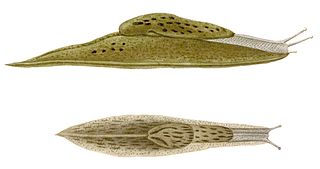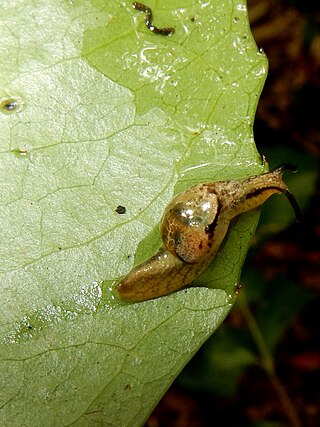
Advena campbelli, also known as the Campbell's keeled glass-snail, is a species of air-breathing land snail, a terrestrial pulmonate gastropod mollusk in the family Helicarionidae. This species is endemic to Norfolk Island. It was listed as extinct by the International Union for Conservation of Nature in 1996. However, the Australian Government lists the species as Critically Endangered, and stated in 2009 that the species' IUCN status was "incorrect and requires updating." A small living population was found in 2020.
The Mount Matafao different snail, scientific name Diastole matafaoi, was a species of air-breathing land snails or semi-slugs, terrestrial pulmonate gastropod mollusks in the family Helicarionidae.
Erepta odontina is a species of air-breathing land snail, a terrestrial pulmonate gastropod mollusk in the family Helicarionidae. This species is endemic to Mauritius.

Erepta stylodon is a species of air-breathing land snail, a terrestrial pulmonate gastropod mollusk in the family Helicarionidae. This species is endemic to Mauritius.
Helicarion australis is a species of air-breathing pulmonate land snail or semi-slug in the family Helicarionidae. This species is endemic to Australia.
Attenborougharion rubicundus is a species of air-breathing semi-slug, terrestrial pulmonate gastropod molluscs in the family Helicarionidae.
Nancibella quintalia is a species of air-breathing land snail or semislug, a terrestrial pulmonate gastropod mollusks in the family Helicarionidae.
Quintalia flosculus is an extinct species of air-breathing land snail or semislug, a terrestrial pulmonate gastropod mollusk in the family Helicarionidae. This species was endemic to Norfolk Island.
Quintalia stoddartii is an extinct species of air-breathing land snail or semislug, a terrestrial pulmonate gastropod mollusk in the family Helicarionidae. This species was endemic to Norfolk Island.
Tubuaia fosbergi is a species of air-breathing land snail or semislug, a terrestrial pulmonate gastropod mollusk in the family Helicarionidae. This species is endemic to the Pitcairn Islands.

Helicarionidae is a family of air-breathing land snails or semi-slugs, terrestrial pulmonate gastropod mollusks in the superfamily Helicarionoidea.

Kalidos mangokyanus is a species of air-breathing land snail, a terrestrial pulmonate gastropod mollusk in the family Helicarionidae.

Mysticarion porrectus, also known as Helicarion porrectus, is a tree-dwelling snail in the family Helicarionidae. It is endemic to Australia. This species occurs in and near rainforests at high altitude in eastern Australia. It is associated with Gondwana cool temperate rainforests, with trees such as Antarctic Beech, Sassafras and Pinkwood.

The caudal mucous pit, or caudal mucous horn, is an anatomical structure on the tail end of the foot of various land snails and slugs, terrestrial pulmonate gastropod mollusks.

Sitala palmaria is a species of air-breathing land snail, terrestrial pulmonate gastropod mollusks in the family Helicarionidae.

Ovachlamys fulgens is a species of air-breathing land snail, a terrestrial pulmonate gastropod mollusk in the family Helicarionidae.

Nitor medioximus is a species of small air-breathing land snail and terrestrial pulmonate gastropod mollusk in the family Helicarionidae. This species is endemic to Australia and grows to about 12 mm in diameter.

Semi-slugs, also spelled semislugs, are land gastropods whose shells are too small for them to retract into, but not quite vestigial. The shell of some semi-slugs may not be easily visible on casual inspection, because the shell may be covered over with the mantle.

Ubiquitarion iridis, the iridescent semi-slug is a tree-dwelling snail in the family Helicarionidae.










